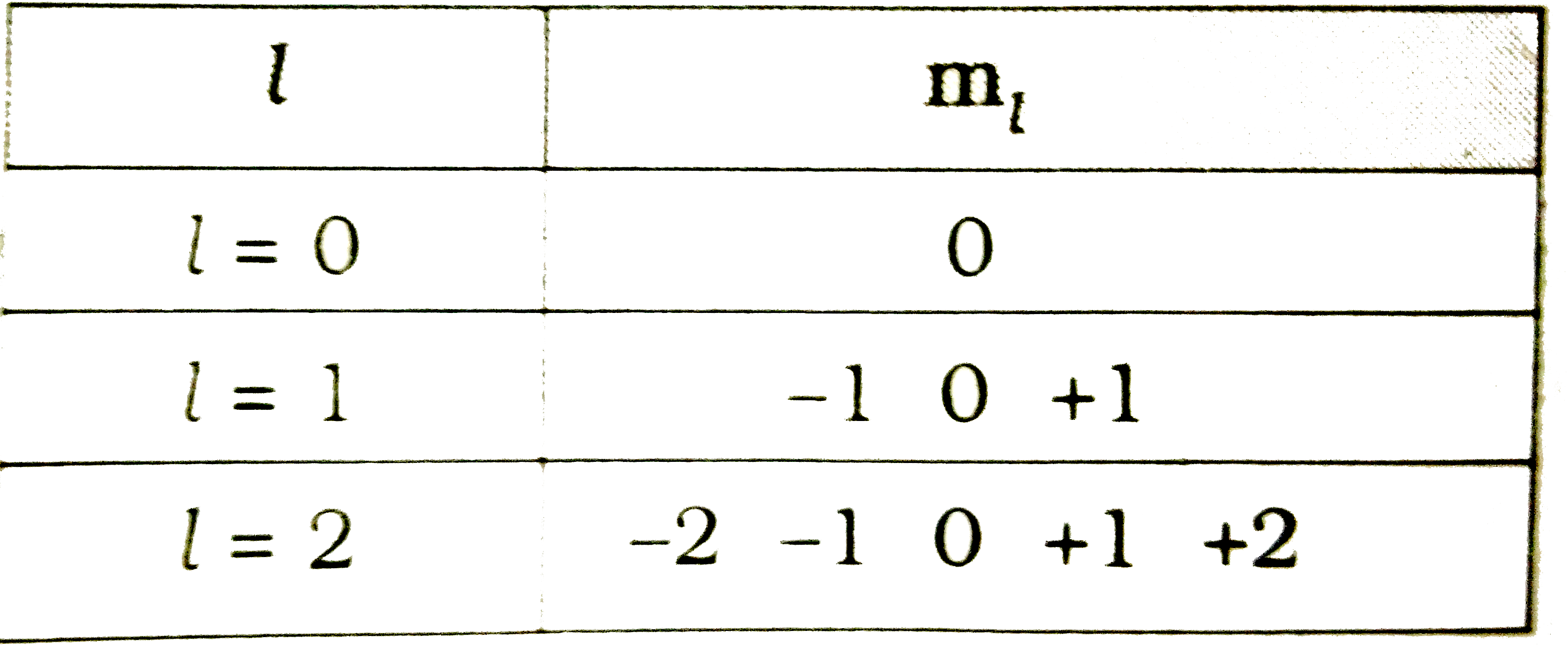For n = 3.
Write all the ml values. Solution in Telugu
For n = 3 . There are 3 l values . Hence

Topper's Solved these Questions
- STRUCTURE OF ATOM BOOK - VGS PUBLICATION-BRILLIANTCHAPTER - STRUCTURE OF ATOM EXERCISE - CREATIVE QUESTIONS FOR NEW MODEL EXAMINATION ( SECTION - IV 4 MARKS )
32 Videos
- STRUCTURE OF ATOM BOOK - VGS PUBLICATION-BRILLIANTCHAPTER - STRUCTURE OF ATOM EXERCISE - CREATIVE QUESTIONS FOR NEW MODEL EXAMINATION ( SECTION - II 1 MARK)
71 Videos
- REFLECTION AND REFRACTIONBOOK - VGS PUBLICATION-BRILLIANTCHAPTER - REFLECTION AND REFRACTIONEXERCISE - EXERCISE
24 Videos
- SUMMATIVE ASSESSMENTBOOK - VGS PUBLICATION-BRILLIANTCHAPTER - SUMMATIVE ASSESSMENTEXERCISE - SUMMATIVE ASSESSMENT
28 Videos
Similar Questions
What are the postulates of Bohr's model of hydrogen atom?
View SolutionWrite the electronic configuration of chromium (Cr) and copper (Cu).
View SolutionThe light reflected by a plane mirror will form a real image
View SolutionWrite any two uses of convex mirror in day to day life.
View SolutionExplain , giving reason , which of the following sets of quantum number are not possible an=0l=0m1=0ms=+1/2bn=1l=0m1=0ms=−1/2cn=1l=0m1=0ms=+1/2dn=2l=1m1=0ms=−1/2en=3l=3m1=−3ms=+1/2fn=3l=1m1=0ms=+1/2
View SolutionGive the possible value for the missing quantum number (s) in each of the following sets. (a) n=3, l=0, m_(l)=? , (b) n=3, l=?, m_(l)=-1 (c) n=?, l=1, m_(l)=+1 , (d) n=?, l=2, m_(l)=? .
View SolutionList all the values of l and m_(1) for n=2 .
View SolutionList the values of l and m_(1) for n=1 .
View Solutionकारण देते हुए, बताइए की निम्नलिखित क्वांटम संख्या के कौन से मान संभव नहीं है-
(क) n=0,l=0,ml=0,ms=+1/2
(ख) n=1,l=0,ml=0,ms=−1/2
(ग) n=1,l=1,ml=0,ms=+1/2
(घ) n=2,l=1,ml=0,ms=−1/2
(ड) n=3,l=3,ml=−3,ms=+1/2
(च) n=3,l=1,ml=0,ms=+1/2
View SolutionExplain, giving reasons, which of the following sets of quantum numbers are not possible. (a) n=0, l=0, m_(1)=0, m_(s)= +1//2 (b) n=1, l=0, m_(l)=0, m_(s)=-1//2 (c) n=1, l=1, m_(l)=-0, m_(s)=+1//2 (d) n=2, l=1, m_(l)=0, m_(s)=-1//2 (e) n=3, l=3, m_(l)=-3, m_(s)=+1//2(f) n=3, l=1, m_(l)=0, m_(s)=+1//2
View Solutionकारण देते हुए बताइए कि निम्नलिखित क्वांटम संख्या के कौन-से मान सम्भव नहीं है?
(क)n=0l=0ml=0ms=+12(ख)n=1l=0ml=0ms=−12(ग)n=1l=1ml=0ms=+12(घ)n=2l=1ml=0ms=−12(ड़)n=3l=3ml=−3ms=+12(च)n=3l=1ml=0ms=+12
View Solutionकारण देते हुए बताइए कि निम्नलिखित क्वांटम संख्याओं के कौन-से समुच्चय सम्भव नहीं है?
n=0, l=0,ml=0mss=+12
n=2, l=0, ml=0mss=−12
n=1,l=1,ml=0,ms=−12
n=2,l=1, ml=0,ms=−12
n=3,l=3, ml=−3,ms=+12
n=3, l=1, ml=0,ms=+12
View Solutionछः एलेक्ट्रोनो की क्वांटम संख्या नीचे दी गई है। इन्हें ऊर्जा के बढ़ते क्रम में व्यवस्थित कीजिए। क्या इनमें से किसी की ऊर्जा समान हैं ?
n=4,l=2, ml=−2,ms=−12
n=3,l=2, ml=1,ms=+12
n=4,l=1, ml=0,ms=+12
n=3,l=2, ml=−2,ms=−12
n=3,l=1, ml=−1,ms=+12
n=4,l=1, ml=0,ms=−12
View SolutionExplain, given reasons, which of the following sets of quantum numbers are not possible. (1) n=0,l=0,ml=0,mS+12
(2) n=1,l=0,ml=0,mS=−12
(3) n=1,l=1,ml=0,mS=+12
(4) n=2, l=1, m1=0,mS=−12
(5) n=3, l=3, ml=−3,mS=+12
(6) n=4, l=1, ml=0,mS=+12.
View SolutionExplain giving reasons , which of the following sets of quantum numbers are not possible .
a) n=0,l=0,ml=0,ms=+12
b) n=1,l=0,ml=0,ms=−12
c) n=1,l=1,ml=0,ms=+12
d) n=2,l=1,ml=0,ms=+12
e) n=3,l=3,ml=−3,ms=+12
f) n=3,l=1,ml=0,ms=+12
View Solution